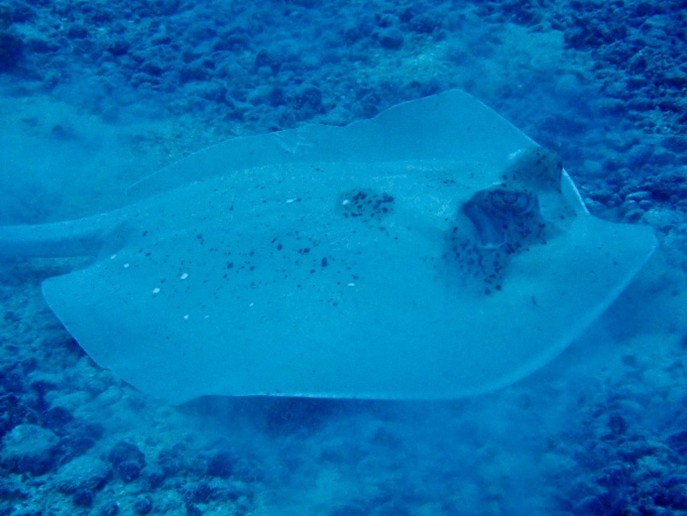News release
From:
Meet Neotrygon romeoi: Fiji’s New Blue-Spotted Maskray
Research conducted at The University of the South Pacific (USP) through the Pacific-European Union Marine Partnership (PEUMP) programme has identified a newly described ray species – the Fiji maskray, Neotrygon romeoi.
The Fiji maskray is part of the blue-spotted maskray complex and is found only in Fijian waters.
Although this ray is common in Fiji – and also the most widely traded one in local markets – it has never undergone a detailed taxonomic description.
That changed when research led by Dr Kerstin Glaus, Research Fellow with the PEUMP programme, funded by the European Union and the Government of Sweden, conducted a landmark study and published this exciting finding open-access in the Journal of Fish Biology on 9 June 2025.
This newly identified species was long confused with Neotrygon kuhlii and N. trigonoides.
However, Dr Glaus’s findings titled A new blue‐spotted Maskray species (Neotrygon, Dasyatidae) from Fiji has now confirmed that Neotrygon romeoi is a completely separate species.
The discovery was confirmed through a combination of detailed measurement of the shape and size of the ray’s body parts such the length of its tail and size of its eyes or fins; counting specific body features like the number of vertebrae; and DNA barcoding which using a small piece of the ray’s DNA to identify what species it is, similar to scanning a barcode to tell products apart.
“It stands out with its broad, angular snout, long claspers in adult males, and a row of thorn-like spines running from the neck to the base of the tail,” Dr Glaus said.
“The ray’s brown back is decorated with dark mask-like markings across the eyes, two large blotches behind the spiracles, and numerous small black spots – especially around the face.”
This research was based on specimens bought from the Suva Fish Market and collected from local fishermen. Importantly, no rays were killed specifically for the study.
For many years, all maskrays were grouped under Neotrygon kuhlii.
Due to modern genetic research, scientists have since uncovered a complex of distinct species. There are now 16 recognised maskray species, with nine described since 2016, and 13 forming the “blue-spotted group”.
The Neotrygon romeoi is now the 17th member of the maskray species complex.
The team named the new species Neotrygon romeoi in honour of the late Romeo Glaus, father of lead author Kerstin Glaus, to acknowledge his enduring support and deep respect for nature.
Beyond its scientific significance, Neotrygon romeoi is frequently caught in small-scale fisheries across Fiji.
“Properly identifying and naming the species is a critical step toward managing its population and ensuring sustainable use,” said Dr Glaus.
“Rays are among the most threatened marine organisms. Given the Fiji maskray’s limited range, high catch rate, and unknown life history, we recommend that it be considered for protection under Fiji’s Endangered and Protected Species Act, which among others applies to endemic sharks and rays and helps conserve native biodiversity by regulating trade, protection, and use of species at risk.”
“This discovery highlights Fiji’s unique natural heritage and the urgent need to better understand and protect our marine species,” said Lavenie Tawake, the USP PEUMP project Team Leader.
So next time you think of Fiji’s underwater wonders, remember: the ocean just got a little more special.
Somewhere beneath the waves, the Fiji maskray, Neotrygon romeoi, glides silently-a newly named symbol of Fiji’s extraordinary marine life.
USP is one of four key implementing partners of the PEUMP Programme, a EUR 45million programme which promotes sustainable management and sound ocean governance for food security and economic growth while addressing climate change resilience and conservation of marine biodiversity.
It follows a comprehensive approach, integrating issues related to ocean fisheries, coastal fisheries, community development, marine conservation and capacity building under one single regional action.
The PEUMP programme is housed within the Centre for Sustainable Futures (CSF) at USP.
Multimedia






 Australia; Pacific
Australia; Pacific



